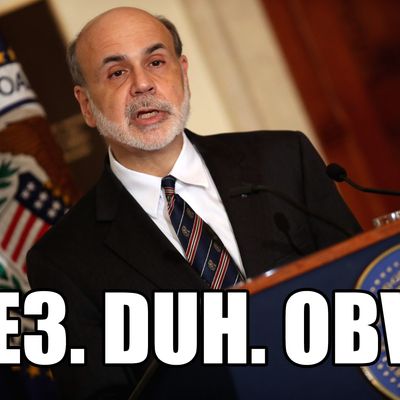
If you’re like most people we know, you don’t get economics and monetary policy. The only bond you’ve ever owned is Gold Bond, you think “fiscal tightening” sounds kinda kinky, and when Fed chairman Ben Bernanke’s face pops up on TV, you’re all, “Ermagerd, look at that funny little bearded man! Do your thing, little cutesy-wootsey wizard man!”
So, you definitely aren’t following the news the Federal Reserve made just now, when it announced it would attempt to stimulate the economy by buying $40 billion worth of mortgage bonds a month indefinitely — a move known colloquially as “QE3” — and keeping the federal funds rate low through at least 2015.
But you should understand this stuff, since it relates to your job prospects, the presidential race, and everything else under the sun. So we’re going to explain it to you, nice and slowly. Stick with us, and you’ll be explaining NGDP targeting in no time.
Oh, hey, what’s up?
Well, the Federal Reserve’s Open Market Committee announced today that —
OMJeezy, have you heard Kate might be preggers? She’s drinking water instead of wine!
Focus here, we’re talking about economics.
Sorry, I just … those babies! Dear God in heaven, I hope they get her hair genes and not Will’s.
Me too. So, about the Fed.
Yeah, what is that, again?
It’s the Federal Reserve. It’s our central bank.
And what does it do?
It has two main tasks: stabilize prices and promote full employment.
Ugh! I got fired from Hollister a few years ago for doing salvia in the break room with my stepbrother, so I can totes sympathize.
Well, okay. I can work with that. Take away Hollister, replace “I did salvia” with “my company is struggling to recover from a deep, lingering recession,” and multiply that experience 12.8 million times over, and you basically have the unemployment crisis the Fed is dealing with.
Are you minimizing my pain?
I’m not. I feel for you, truly. Anyway, historically, the Fed has tried to stimulate the economy and recover lost jobs by lowering interest rates. But right now, rates are near zero, and they can’t get any lower. So, today, after months of hand-wringing and a terrible jobs report last week, the Fed decided to try plan B: a new round of quantitative easing. It’s the third time they’ve done this, so people are calling it QE3.
What’s that? Also, you said “stimulate.”
Ignoring that. Quantitative easing is the Fed’s way of stimulating the economy by flooding it with new money. It’s supposed to lower long-term interest rates and boost the value of stocks and real estate and eventually help make it easier for companies to hire more workers.
Um, hold on. Back to that first thing you said. The Fed can create new money? Second question: Can it HOLLER AT ME?
Well, not literally. There are no actual dollar bills being printed. But yes, in effect, the Fed can pump as much new money into the financial system as it wants. And no, I don’t believe Ben Bernanke and the Federal Open Market Commission will “holler” at you.
Fine, be that way. So, what does the Fed do with all its new money?
Basically, it goes to banks, asks them, “What are some things you wish you could get rid of?” and then buys those things for more than the going rate. Usually, they’re things like government bonds. Today, they’re mortgage-backed securities.
I wish I could get rid of my dog. Do you know you have to feed them EVERY DAY?
I did know that. Anyway, by giving banks a fresh supply of new money and taking unwanted assets off their hands, the Fed hopes that those banks will start making loans to people and companies again, and the economy will recover more fully.
Pretty nifty. Does it work?
Well, about that. The Fed has done this twice before, buying around $2 trillion worth of stuff, as well as a third related tactic known as Operation Twist that involved swapping out short-term bonds for long-term bonds.
All three times it acted, the Fed has achieved a narrow set of aims, and Wall Street has enjoyed brief market rallies, but the broader recovery hasn’t exactly materialized yet. They’re hoping that this time, with a combination of large-scale asset purchases and an extension of its rate guidance (basically, telling us that interest rates will stay extremely low until at least 2015), the third round will work better.
Well that’s dumb. Didn’t Adam Levine say, “Insanity is doing the same things over and over again and expecting different results?”
I think you mean Albert Einstein, and it wasn’t even him. And anyway, things are different now than they were when QE2 was announced. Europe has turned a corner, the jobs picture is slowly improving, and a little more stimulative action might actually be enough to get the economy over the hump. The FOMC promised today that it will keep buying bonds “if the outlook for the labor market does not improve substantially,” and in Fed-land, an open-ended commitment that takes the labor market (and not just interest rates) into account is one of the most meaningful measures we could have hoped for.
So, what you’re saying is that now that the Fed has announced an open-ended QE3, everyone will have jobs and lots of money and we’ll all be just as happy as the Gangnam Style guy? [Does Gangnam Style dance.]
Not really. The economy still has structural challenges, Europe is a long way from saved, and unemployment is still a chronic problem that American policy-makers are giving short shrift. Even if the Fed’s action today lowers rates in the short term, a survey of economists conducted by The Wall Street Journal showed that most experts only expected a hypothetical $500 billion QE3 to reduce the unemployment rate by 0.1 percent over the next year, while leaving GDP virtually —
Can’t hear you! Still dancing!





























